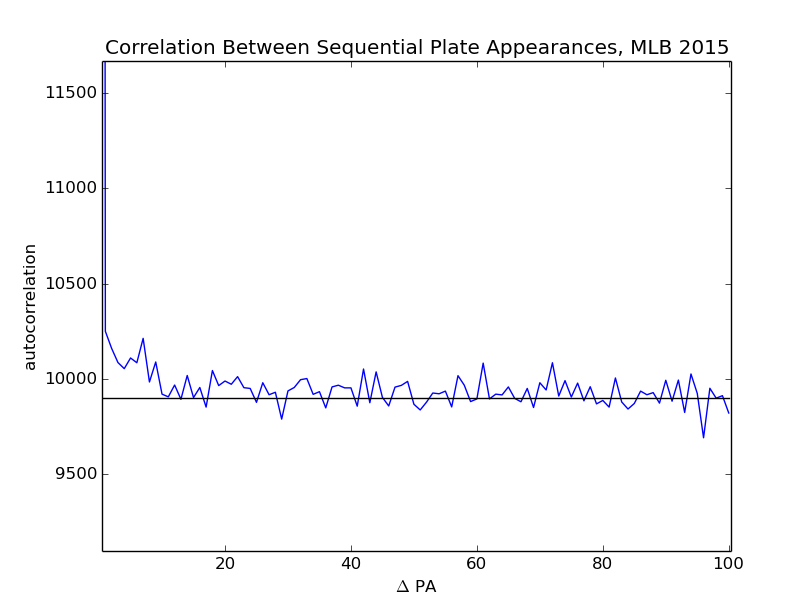You've Reached the Center of the Internet
It's a blog
The Hot Hand Fallacy?
I was reading the Wikipedia article about the Hot Hand Fallacy, and I decided to try a little bit of statistical analysis myself. I've always found the idea of a player being hot or cold a bit suspicious. On one hand, it kind of feels right. Sometimes a player just has it, right? And there's no reason events in a game need to be considered completely independent. On the other hand, maybe the phenomenon can be explained by our natural inclination to look for patterns.
I chose baseball to look at. I downloaded the 2015 event database from Retrosheet, and wrote some code to calculate autocorrelation functions. I generated a long list of every plate appearance outcome for the whole season. The list is grouped by player and in order for each player. I labeled all hits as 1 and all outs as 0. I then computed the autocorrelation of this sequence.

I inserted the black line to guide the eye. As you can see, there is some correlation between successful plate appearances. I think this suggests that the time-scale for hotness or coldness is about ten plate appearances. Two games, or so. Also, it isn't a huge effect. It looks like 5% or something.
import numpy as np
import matplotlib.pyplot as plt
import os
from compiler.ast import flatten
# gets only the event lines from a file
def getEvents(filename):
fp = open(filename)
# splits line into parts
lines = map(lambda line: line.split(","),fp)
# filters for only play events
events = filter(lambda line: line[0] == "play", lines)
return events
# gets a list of players involved in a list of events
def getPlayers(events):
names = map(lambda event: event[3], events)
players = list(set(names))
return players
# filters for only plays involving a certain hitter
def getEventsBy(events, name):
return filter(lambda event: (event[3] == name), events)
# maps hits to 1 and outs to 0
def maskHits(events):
return map(lambda event: 1 if ((event[6][0] == "S") or (event[6][0] == "D") or (event[6][0] == "T") or (event[6][0] == "H")) else 0, events)
# replaces all lines containing a hit with a 1 and all containing and out with a 0
def getPlayerSeries(events, name):
return maskHits(getEventsBy(events, name))
# concatenates all the player series for a team
def getPlayerSeriesForTeam(filename):
events = getEvents(filename)
players = getPlayers(events)
series = map(lambda player: getPlayerSeries(events, player), players)
return flatten(series)
# concatenates the team series for the whole league
files = os.listdir('./teams')
total_series = map(lambda file: getPlayerSeriesForTeam('./teams/' + file), files)
total_series_flat = flatten(total_series)
print len(total_series_flat)
corr = np.correlate(np.concatenate((total_series_flat,total_series_flat[:100])), total_series_flat, mode='valid')
print corr
plt.plot(corr)
plt.plot([0, 100], [9900, 9900], 'k-')
plt.title("Correlation Between Sequential Plate Appearances, MLB 2015 ")
plt.xlabel(r'$\Delta$ PA')
plt.ylabel('autocorrelation')
plt.show()